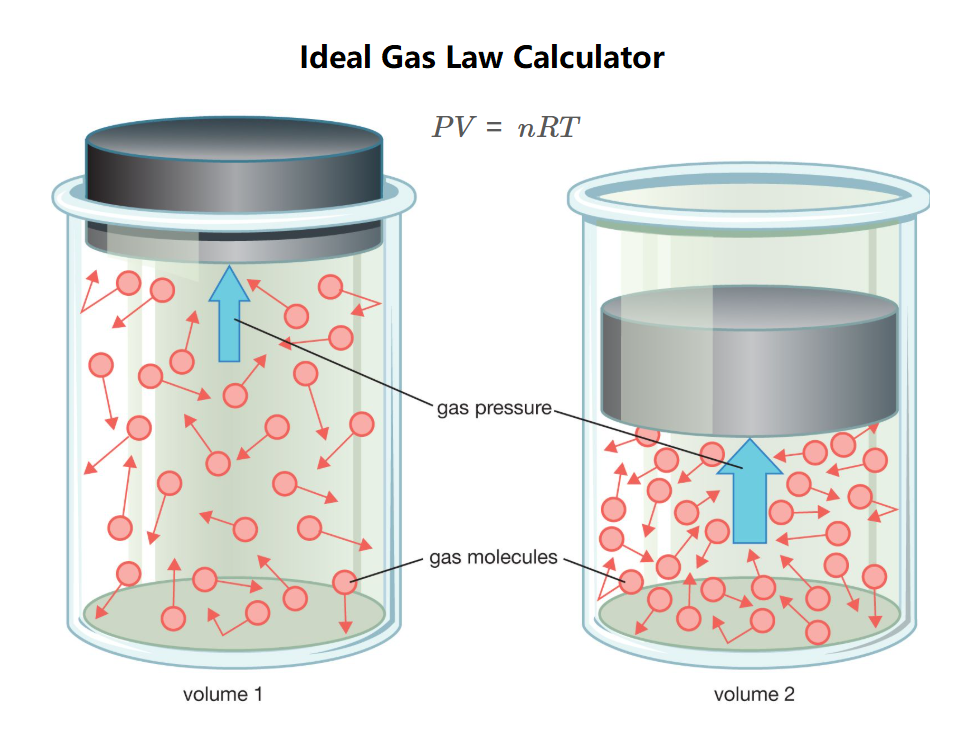

A PV nRT calculator is a tool used to calculate properties of an ideal gas based on the ideal gas law, expressed as \( PV = nRT \). This equation relates pressure (\( P \)), volume (\( V \)), number of moles (\( n \)), gas constant (\( R \)), and temperature (\( T \)). To use this calculator, you need to input known values, such as the gas’s pressure, volume, temperature, or amount of substance, along with their respective units (e.g., Pa, atm, liters, Kelvin, moles). Some calculators may allow you to specify the gas constant or select a substance to account for its molar mass. Based on these inputs, the PV nRT calculator will compute the unknown variable, ensuring accurate results for gas behavior. This helps in applications like chemical reactions, gas storage design, and thermodynamic analysis, optimizing calculations for efficiency and precision.
The Ideal Gas Law, expressed as
\( PV = nRT \)
is a fundamental equation that describes the relationship between:
| Symbol | Meaning | Common Units |
|---|---|---|
| P | Pressure | atm, Pa, bar, mmHg |
| V | Volume | L, m³, cm³ |
| n | Moles of gas | mol |
| R | Universal Gas Constant | 0.0821 L·atm/(mol·K) or 8.314 J/(mol·K) |
| T | Temperature (Kelvin) | K |
Example 1: Calculate the volume of 200 g of a custom gas with molar weight 50 g/mol at 159 kPa and 80°F, using \( R = 8.3145 \, \text{J/(mol·K)} \), with output in l:
Results (change output unit to l):
Example 2: Find the temperature of a gas with 2 l volume, 0.0817 mol, at 1 atm, using \( R = 8.3145 \, \text{J/(mol·K)} \), with temperature output in °F:
Results (change output unit to °F):
| Components in dry air | Molar Mass (g/mol) (kg/kmol) |
Molar mass in air | ||
|---|---|---|---|---|
| Name | Formula | (g/mol) (kg/kmol) |
(g/molair) (kg/kmolair) |
(wt %) |
| Nitrogen | N2 | 28.013 | 21.873983 | 75.52 |
| Oxygen | O2 | 31.999 | 6.702469 | 23.14 |
| Argon | Ar | 39.948 | 0.373114 | 1.29 |
| Carbon dioxide | CO2 | 44.010 | 0.014677 | 0.051 |
| Neon | Ne | 20.180 | 0.000367 | 0.0013 |
| Helium | He | 4.003 | 0.000021 | 0.00007 |
| Methane | CH4 | 16.042 | 0.000029 | 0.00010 |
| Krypton | Kr | 83.798 | 0.000084 | 0.00030 |
| Hydrogen | H2 | 2.016 | 0.000001 | 0.00003 |
| Xenon | Xe | 131.293 | 0.000012 | 0.00004 |
| Average molar mass of air | 28.9647 | |||
| Substance | Molar Mass (M) | Specific Gas Constant (Rₛ) |
|---|---|---|
| Air | 28.97 g/mol | 287.1 J/(kg·K) |
| Argon | 39.95 g/mol | 208.1 J/(kg·K) |
| Butane | 58.12 g/mol | 143.1 J/(kg·K) |
| Carbon dioxide | 44.01 g/mol | 188.9 J/(kg·K) |
| Carbon monoxide | 28.01 g/mol | 296.8 J/(kg·K) |
| Ethane | 30.07 g/mol | 276.5 J/(kg·K) |
| Ethylene | 28.05 g/mol | 296.3 J/(kg·K) |
| Helium | 4.00 g/mol | 2078.6 J/(kg·K) |
| Hydrogen | 2.02 g/mol | 4119.0 J/(kg·K) |
| Methane | 16.04 g/mol | 518.3 J/(kg·K) |
| Neon | 20.18 g/mol | 411.9 J/(kg·K) |
| Nitrogen | 28.01 g/mol | 296.8 J/(kg·K) |
| Octane | 114.23 g/mol | 72.8 J/(kg·K) |
| Oxygen | 32.00 g/mol | 259.8 J/(kg·K) |
| Propane | 44.10 g/mol | 188.6 J/(kg·K) |
| Steam (Water vapor) | 18.02 g/mol | 461.5 J/(kg·K) |
Q: What is an ideal gas?
A: An ideal gas is a theoretical gas with molecules that have no volume, no intermolecular forces, and perfectly elastic collisions. Real gases approximate ideal behavior at low pressures and high temperatures.
Q: How do I choose the correct gas?
A: Select a gas from the dropdown for common substances (e.g., Carbon dioxide: 44.01 g/mol) or choose "Custom" to enter your own molar weight in g/mol for other gases.
Q: Why use Kelvin for temperature calculations?
A: Kelvin is an absolute temperature scale starting at absolute zero, ensuring positive values for calculations, though inputs and outputs can be in °C or °F.
Q: Can this calculator be used for real gases?
A: Yes, for real gases at low pressures and high temperatures, but deviations occur near condensation points. For real gases, consider the van der Waals equation.
Q: Can I change the gas constant or output units?
A: Yes, the gas constant (\( R \)) defaults to 8.3145 J/(mol·K) but can be edited. Output units for pressure (e.g., kPa, bar), volume (e.g., l, cm³), and temperature (K, °C, °F) can be changed interactively in the results section.